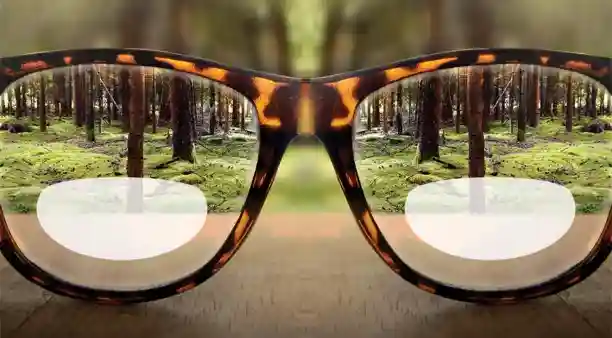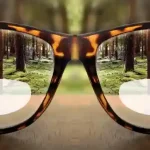The advent of bifocal lenses marked a significant milestone in corrective eyewear, offering a practical solution for individuals with near and distant vision problems. If you’ve ever wondered what a bifocal lens is, its purpose, or how it works, this guide is for you.
From understanding why bifocal lens is used in specific conditions to exploring the bifocal lens types, this comprehensive guide covers everything you need to know.
What is Bifocal Lens?
A bifocal lens is a type of eyeglass lens designed to correct two different types of vision problems in a single lens. The lens is divided into two distinct segments:
- The upper portion is typically used for distance vision.
- The lower portion is designed to help with near-vision tasks like reading or sewing.
What Is Bifocal Lens Used For?
Bifocal lens is used for managing multiple vision issues without switching between separate pairs of glasses. It is a convenient solution for those who experience:
- Presbyopia: Age-related difficulty in focusing on close objects.
- Myopia (Nearsightedness): Difficulty seeing distant objects clearly.
- Hyperopia (Farsightedness): Difficulty seeing nearby objects clearly.
By combining two prescriptions in one lens, bifocals eliminate the need for multiple pairs of glasses.
Why Are Bifocal Lenses Required to Correct Vision Problems?
As we age, the lens in our eyes becomes less flexible, reducing the ability to focus on objects at different distances. This condition, known as presbyopia, is why bifocal lens are required to correct vision.
Bifocals provide a practical solution by addressing both near and distance vision issues in one pair of glasses. The convenience and functionality of bifocals make them an ideal choice for individuals over the age of 40 who experience presbyopia.
Bifocal Lens Types
There are several types of bifocal lenses designed to suit different preferences and needs:
Traditional Bifocals
- Features a visible line dividing the near and distance segments.
- Provides a clear distinction between the two prescriptions.
Progressive Lenses (No-Line Bifocals)
- Offers a gradual transition between prescriptions without visible lines.
- Provides a more natural viewing experience.
Flat-Top (D-Segment) Bifocals
- The near-vision segment has a flat top, resembling the shape of the letter “D.”
- One of the most common designs.
Round-Segment Bifocals
- Features a round segment for near vision, placed at the bottom of the lens.
Executive Bifocals
- The near and distance segments run across the entire width of the lens.
- Provides a wide field of vision for both segments.
Selecting the right bifocal lens type depends on your visual needs, lifestyle, and aesthetic preferences.
Also Read: Monofocal vs. Multifocal Lenses
Benefits of Bifocal Lenses
Convenience
With a bifocal lens, you no longer need to carry multiple pairs of glasses for different activities.
Improved Vision
Bifocals ensure sharp vision for both near and far distances, making daily tasks easier and more comfortable.
Cost-Effectiveness
Investing in bifocal lenses eliminates the need for separate reading and distance glasses, saving both time and money.
Versatility
Bifocal lenses are available in various styles and materials, making them suitable for people of all ages and lifestyles.
Caring for Your Bifocal Lenses
Proper care ensures the longevity and effectiveness of your bifocal lenses:
- Clean Regularly: Use a microfiber cloth and lens cleaner to prevent scratches and smudges.
- Store Properly: Keep your glasses in a protective case when not in use.
- Avoid Harsh Chemicals: Use only recommended cleaning solutions to avoid damaging the lens coating.
Challenges Associated with Bifocal Lenses
While bifocal lenses offer numerous advantages, there are a few challenges to consider:
- Adjustment Period: Some users may experience difficulty adapting to bifocal lenses, particularly when transitioning between segments.
- Limited Mid-Range Vision: Traditional bifocals may not provide optimal vision for intermediate distances.
- Cosmetic Concerns: The visible line in traditional bifocals may not appeal to everyone.
Discussing these concerns with your eye specialist can help you find the best solution for your needs.
Alternatives to Bifocal Lenses
If you find bifocal lenses challenging to use, there are alternative options to consider:
- Progressive Lenses: A no-line alternative providing a seamless transition between prescriptions.
- Contact Lenses: Multifocal or bifocal contact lenses offer similar functionality without the need for glasses.
- Refractive Surgery: Laser vision correction procedures like LASIK can eliminate the need for corrective lenses in some cases.
Whether you’re seeking information on what is bifocal lens, or curious about how bifocal lens is used to correct vision issues, Centre for Sight is here to guide you.
Take the first step toward healthier, more beautiful eyes Book an Appointment with Centre for Sight in India!
Frequently Asked Questions
Bifocal lenses are used to correct vision for individuals who have difficulty seeing clearly at both near and far distances. They contain two distinct optical powers in one lens, typically with the upper portion for distance vision and the lower portion for near vision.
Bifocal lenses can have both concave and convex sections, depending on the specific prescription and design. The upper portion for distance vision is usually concave (minus power), while the lower portion for near vision is convex (plus power).
The choice between bifocal and progressive lenses depends on individual preferences and visual needs. Bifocals have a distinct line separating the near and distance portions, which some people find easier to adapt to. Progressive lenses offer a seamless transition between near, intermediate, and distance vision without any lines, providing a more natural visual experience for many wearers.
Yes, you can wear bifocal lenses all the time if they are prescribed for full-time use. However, it may take some time to adjust to wearing bifocals continuously, especially if you are not accustomed to wearing multifocal lenses. It’s important to follow your eye care professional’s recommendations and wear your bifocals consistently for optimal vision correction.
Both have their advantages. Bifocal lenses offer distinct sections for near and far vision but include a visible line. Progressive lenses provide a gradual transition between prescriptions without a visible line, making them more aesthetically pleasing and suitable for intermediate vision.
Bifocal lenses typically combine both concave and convex segments. The upper portion (for distance vision) is often concave for myopia, while the lower portion (for near vision) is convex to correct presbyopia.
Individuals with presbyopia or those requiring correction for both near and distance vision typically need bifocal lenses. They are especially common in people over 40, as the eye’s ability to focus on close objects diminishes with age.





